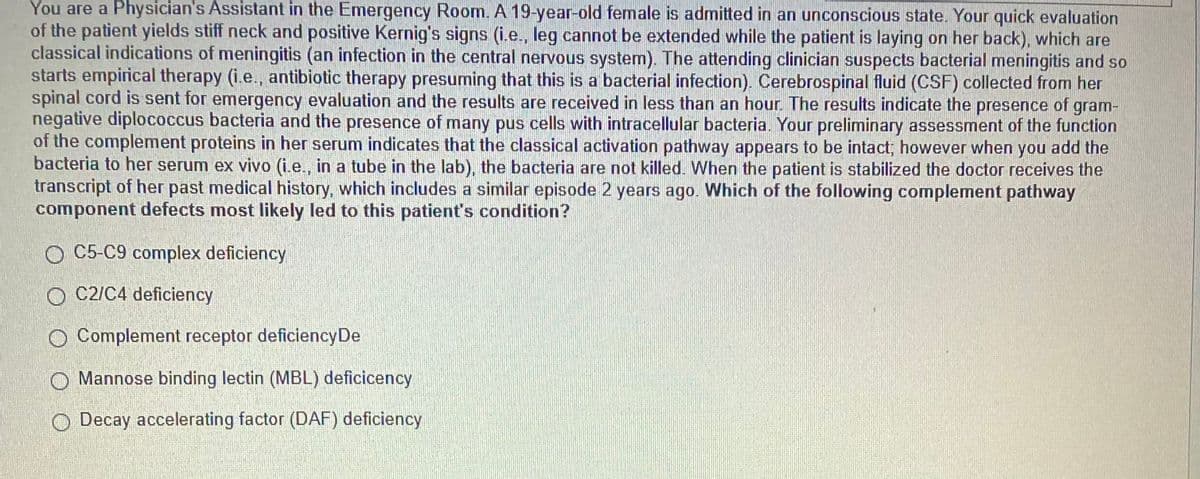You are a Physician's Assistant in the Emergency Room. A 19-year-old female is admitted in an unconscious state. Your quick evaluation of the patient yields stiff neck and positive Kernig's signs (i.e., leg cannot be extended while the patient is laying on her back), which are classical indications of meningitis (an infection in the central nervous system). The attending clinician suspects bacterial meningitis and so starts empirical therapy (i.e., antibiotic therapy presuming that this is a bacterial infection). Cerebrospinal fluid (CSF) collected from her spinal cord is sent for emergency evaluation and the results are received in less than an hour. The results indicate the presence of gram- negative diplococcus bacteria and the presence of many pus cells with intracellular bacteria. Your preliminary assessment of the function of the complement proteins in her serum indicates that the classical activation pathway appears to be intact; however when you add the bacteria to her serum ex vivo (i.e., in a tube in the lab), the bacteria are not killed. When the patient is stabilized the doctor receives the transcript of her past medical history, which includes a similar episode 2 years ago. Which of the following complement pathway component defects most likely led to this patient's condition? O C5-C9 complex deficiency O C2/C4 deficiency O Complement receptor deficiency De O Mannose binding lectin (MBL) deficicency Decay accelerating factor (DAF) deficiency
You are a Physician's Assistant in the Emergency Room. A 19-year-old female is admitted in an unconscious state. Your quick evaluation of the patient yields stiff neck and positive Kernig's signs (i.e., leg cannot be extended while the patient is laying on her back), which are classical indications of meningitis (an infection in the central nervous system). The attending clinician suspects bacterial meningitis and so starts empirical therapy (i.e., antibiotic therapy presuming that this is a bacterial infection). Cerebrospinal fluid (CSF) collected from her spinal cord is sent for emergency evaluation and the results are received in less than an hour. The results indicate the presence of gram- negative diplococcus bacteria and the presence of many pus cells with intracellular bacteria. Your preliminary assessment of the function of the complement proteins in her serum indicates that the classical activation pathway appears to be intact; however when you add the bacteria to her serum ex vivo (i.e., in a tube in the lab), the bacteria are not killed. When the patient is stabilized the doctor receives the transcript of her past medical history, which includes a similar episode 2 years ago. Which of the following complement pathway component defects most likely led to this patient's condition? O C5-C9 complex deficiency O C2/C4 deficiency O Complement receptor deficiency De O Mannose binding lectin (MBL) deficicency Decay accelerating factor (DAF) deficiency
Anatomy & Physiology
1st Edition
ISBN:9781938168130
Author:Kelly A. Young, James A. Wise, Peter DeSaix, Dean H. Kruse, Brandon Poe, Eddie Johnson, Jody E. Johnson, Oksana Korol, J. Gordon Betts, Mark Womble
Publisher:Kelly A. Young, James A. Wise, Peter DeSaix, Dean H. Kruse, Brandon Poe, Eddie Johnson, Jody E. Johnson, Oksana Korol, J. Gordon Betts, Mark Womble
Chapter15: The Autonomic Nervous System
Section: Chapter Questions
Problem 6ILQ: Watch this video (http://openstaxcollege.org/l/3Dmovies) to learn about the side effects of 3-D...
Related questions
Question

Transcribed Image Text:You are a Physician's Assistant in the Emergency Room. A 19-year-old female is admitted in an unconscious state. Your quick evaluation
of the patient yields stiff neck and positive Kernig's signs (i.e., leg cannot be extended while the patient is laying on her back), which are
classical indications of meningitis (an infection in the central nervous system). The attending clinician suspects bacterial meningitis and so
starts empirical therapy (i.e., antibiotic therapy presuming that this is a bacterial infection). Cerebrospinal fluid (CSF) collected from her
spinal cord is sent for emergency evaluation and the results are received in less than an hour. The results indicate the presence of gram-
negative diplococcus bacteria and the presence of many pus cells with intracellular bacteria. Your preliminary assessment of the function
of the complement proteins in her serum indicates that the classical activation pathway appears to be intact; however when you add the
bacteria to her serum ex vivo (i.e., in a tube in the lab), the bacteria are not killed. When the patient is stabilized the doctor receives the
transcript of her past medical history, which includes a similar episode 2 years ago. Which of the following complement pathway
component defects most likely led to this patient's condition?
O C5-C9 complex deficiency
O C2/C4 deficiency
O Complement receptor deficiency De
O Mannose binding lectin (MBL) deficicency
Decay accelerating factor (DAF) deficiency
Expert Solution
This question has been solved!
Explore an expertly crafted, step-by-step solution for a thorough understanding of key concepts.
Step by step
Solved in 2 steps

Follow-up Questions
Read through expert solutions to related follow-up questions below.
Follow-up Question
Your answer is incorrect please revise. Thanks
Solution
Knowledge Booster
Learn more about
Need a deep-dive on the concept behind this application? Look no further. Learn more about this topic, biology and related others by exploring similar questions and additional content below.Recommended textbooks for you

Anatomy & Physiology
Biology
ISBN:
9781938168130
Author:
Kelly A. Young, James A. Wise, Peter DeSaix, Dean H. Kruse, Brandon Poe, Eddie Johnson, Jody E. Johnson, Oksana Korol, J. Gordon Betts, Mark Womble
Publisher:
OpenStax College

Human Physiology: From Cells to Systems (MindTap …
Biology
ISBN:
9781285866932
Author:
Lauralee Sherwood
Publisher:
Cengage Learning


Anatomy & Physiology
Biology
ISBN:
9781938168130
Author:
Kelly A. Young, James A. Wise, Peter DeSaix, Dean H. Kruse, Brandon Poe, Eddie Johnson, Jody E. Johnson, Oksana Korol, J. Gordon Betts, Mark Womble
Publisher:
OpenStax College

Human Physiology: From Cells to Systems (MindTap …
Biology
ISBN:
9781285866932
Author:
Lauralee Sherwood
Publisher:
Cengage Learning


Human Biology (MindTap Course List)
Biology
ISBN:
9781305112100
Author:
Cecie Starr, Beverly McMillan
Publisher:
Cengage Learning
